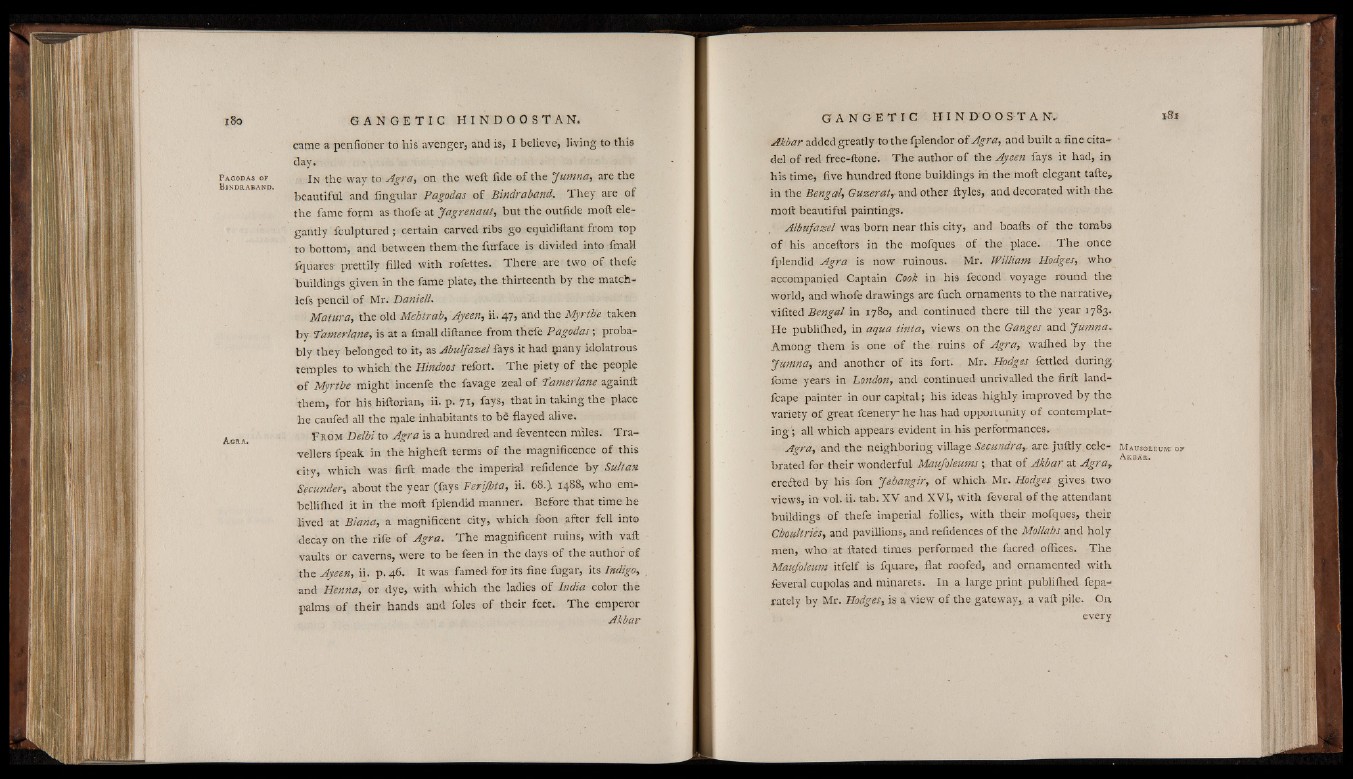
P a g o d a s o f
B in d r a b a n d .
A g r a «
came a penfioner to his avenger, and is, I believe, living to this
day.
In the way to Agra, on the weft fide of the Jumna, are the
beautiful and fingular Pagodas of Bindraband. They are of
the fame form as thofe at Jagrenaut, but the outfide moft elegantly
fculptured; certain carved ribs go equidiftant from top
to bottom, and between them the furface is divided into final!
fi] vs arcs prettily filled with rofettes. There are two o f thefe
buildings given in the fame plate, the thirteenth by the match-
lefs pencil of Mr. Daniell.
Matura, the old Mehtrah, Ayeen, ii. 47, and the Myrthe taken
by Tamerlane, is at a fmall diftanee from thefe Pagodas; probably
they belonged to it, as Abulfazel fays it had many idolatrous
temples to which the Hindoos refort. The piety of the people
of Myrtbe might incenfe the favage zeal of Tamerlane againft
them, for his hiftorian, ii. p. 71, fays, that in taking the place
he caufed all the male inhabitants to be flayed alive.
F r o m Delhi to Agra is a hundred and feventeen miles. Travellers
fpeak in the higheft terms of the magnificence of this
city, which was firft made the imperial refidence by Sultan
Secunder, about the year (fays Perijbta, ii. 68.). 1488, who em-
bellifhed it in the moft fplendid manner. Before that time he
lived at Biana, a magnificent city, which foon after fell into
decay on the rile of Agra. The magnificent ruins, with vaft
vaults or caverns, were to be feen in the days o f the author o f
the Ayeen, ii. p. 46. It was famed for its fine fugar, its Indigo,
and Henna, or dye, with which the ladies of India color the
palms o f their hands and foies of their feet. The emperor
Akbar
Akbar added greatly to the fplendor o f Agra, and built a fine citadel
of red free-ftone. The author o f the Ayeen fays it had, in
his time, five hundred ftone buildings in the moft elegant tafte,
in the Bengal, Guzerat, and other ftyles, and decorated with the
moft beautiful paintings.
Albnfazel was born near this city, and boafts o f the tombs
of his anceftors in the mofques o f the place. The once
fplendid Agra is now ruinous. Mr. William Hodges, who.
accompanied Captain Cook in his fecond voyage round the
world, and whofe drawings are fuch ornaments to the narrative,
vilited Bengal in 1780, and continued there till the year 1783.
He publifhed, in aqua tinta, views on the Ganges and Jumna.
Among them is one of the ruins of Agra, waihed by the
Jumna, and another of its fort. Mr. Hodges fettled during
feme years in London, and continued unrivalled the firft land-
fcape painter in our capital; his ideas.highly improved by the
variety o f great fcenery* he has had opportunity of contemplating';
all which appears evident in his performances.
Agra, and the neighboring village Secundra,, are. juftly celebrated
for their wonderful Maufoleums ; that o f Akbar at Agra,
eretted by his fon Jebangir, of which Mr. Hodges gives- two
views, in vol. ii. tab. XV and XVI, with feveral of the attendant
buildings o f thefe imperial follies, with their mofques, their
Choultries, and pavillions, and refidences of the Mollahs and holy
men, who at Hated times performed the facred offices. The
Maufoleum itfelf is fq.uare, flat roofed, and ornamented with
feveral cupolas and minarets. In a large print publifhed fepa-
rately by Mr. Hodges, is a view of the gateway,, a vaft pile. On
every
M a u so e e u m t o f
A k b A r .